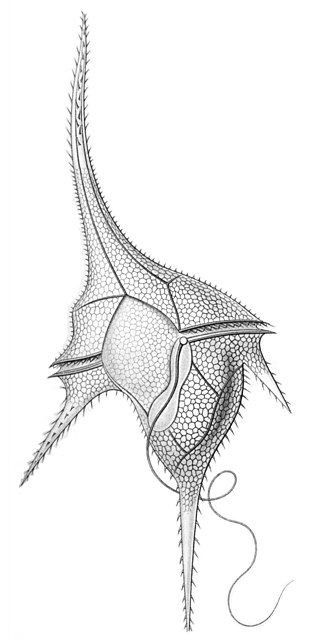
The dinoflagellates are a monophyletic group of single-celled eukaryotes constituting the phylum Dinoflagellata and are usually considered protists. Dinoflagellates are mostly marine plankton, but they also are common in freshwater habitats. Their populations vary with sea surface temperature, salinity, and depth. Many dinoflagellates are photosynthetic, but a large fraction of these are in fact mixotrophic, combining photosynthesis with ingestion of prey.

Dinokaryota is a main grouping of dinoflagellates. They include all species where the nucleus remains a dinokaryon throughout the entire cell cycle, which is typically dominated by the haploid stage. All the "typical" dinoflagellates, such as Peridinium and Gymnodinium, belong here. Others are more unusual, including some that are colonial, amoeboid, or parasitic. Symbiodinium contains the symbiotic zooxanthellae.

Pfiesteria piscicida is a dinoflagellate species of the genus Pfiesteria that some researchers claim was responsible for many harmful algal blooms in the 1980s and 1990s on the coast of North Carolina and Maryland. North Carolinian media in the 1990s referred to the organism as the cell from hell. It is known to populate estuaries. Piscicida means "fish-killer".
Alexandrium fundyense is a species of dinoflagellates. It produces toxins that induce paralytic shellfish poisoning (PSP), and is a common cause of red tide. A. fundyense regularly forms massive blooms along the northeastern coasts of the United States and Canada, resulting in enormous economic losses and public health concerns.

Gambierdiscus toxicus is a species of photosynthetic unicellular eukaryote belonging to the Alveolata, part of the SAR supergroup. It is a dinoflagellate which can cause the foodborne illness ciguatera, and is known to produce several natural polyethers including ciguatoxin, maitotoxin, gambieric acid, and gambierol. The species was discovered attached to the surface of brown macroalgae.

Dinophyceae is a class of dinoflagellates.
Gonyaulax is a genus of dinoflagellates with the type species Gonyaulax spinifera Diesing. Gonyaulax belongs to red dinoflagellates and commonly causes red tides. It can produce yesotoxins: for example, strains of Gonyaulax spinifera from New Zealand are yessotoxin producers.
Luciella masanensis is a species of heterotrophic marine dinoflagellates.
Gambierdiscus pacificus is a species of toxic dinoflagellate. It is 67–77 μm long and 60–76 μm wide dorsoventrally and its surface is smooth. It is identified by a four-sided apical pore plate surrounded by 30 round pores. Its first plate occupies 20% of the width of the hypotheca.
Gambierdiscus australes is a species of toxic dinoflagellate. It is 76–93 μm long and 65–85 μm wide dorsoventrally and its surface is smooth. It is identified by a broad ellipsoid apical pore plate surrounded by 31 round pores. Its first plate occupies 30% of the width of the hypotheca.
Gambierdiscus polynesiensis is a species of toxic dinoflagellate. It is 68–85 μm long and 64–75 μm wide dorsoventrally and its surface is smooth. It is identified by a large triangular apical pore plate, a narrow fish-hook opening surrounded by 38 round pores, and a large, broad posterior intercalary plate. Its first plate occupies 60% of the width of the hypotheca.
Karenia papilionacea is a species from the genus Karenia, which are dinoflagellates. It was first discovered in New Zealand.
Karenia selliformis is a species from the genus Karenia, which are dinoflagellates. It was first discovered in New Zealand. Karenia selliformis produces the highly toxic gymnodimine, and as such is a potentially harmful ocean dweller. Gymnodimine is a nicotinic acetylcholine receptor-blocking phycotoxin, a source of shellfish poisoning.
Karenia bicuneiformis, also known as Karenia bidigitata is a microbial species from the genus Karenia, which are dinoflagellates. It was first discovered in New Zealand.
Karlodinium ballantinum is a species of unarmored dinoflagellates from the genus Karlodinium. It was first isolated from the Australian region of the Southern Ocean. It is small-sized and is characterized by its very short apical groove. It is considered potentially ichthyotoxic.
Gambierdiscus caribaeus is a species of toxic dinoflagellate, which among others causes ciguatera fish poisoning. It is photosynthetic and epibenthic.
Gambierdiscus carpenteri is a species of toxic dinoflagellate, which among others causes ciguatera fish poisoning. It is photosynthetic and epibenthic.
Gambierdiscus ruetzleri is a species of toxic dinoflagellates, which among others causes ciguatera fish poisoning. It is photosynthetic and epibenthic.

Gambierdiscus is a genus of marine dinoflagellates that produce ciguatoxins, a type of toxin that causes the foodborne illness known as ciguatera. They are usually epiphytic on macroalgae growing on coral reefs.
Coolia is a marine dinoflagellate genus in the family Ostreopsidaceae. It was first described by Meunier in 1919. There are currently seven identified species distributed globally in tropical and temperate coastal waters. Coolia is a benthic or epiphytic type dinoflagellate: it can be found adhered to sediment or other organisms but it is not limited to these substrates. It can also be found in a freely motile form in the water column. The life cycle of Coolia involves an asexual stage where the cell divides by binary fission and a sexual stage where cysts are produced. Some of the species, for example, Coolia tropicalis and Coolia malayensis, produce toxins that can potentially cause shellfish poisoning in humans.




